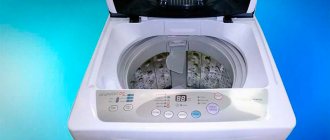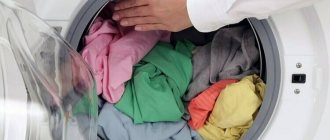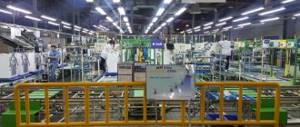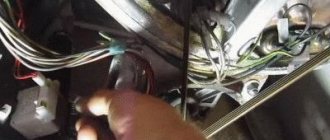There are 3 groups of devices designed for cleaning laundry: manually controlled, automatic washing machines (SMA), and semi-automatic (SMPA). The latter devices occupy an intermediate position between the other two and have special advantages, combining the advantages of both groups. Operating such machines does not cause any difficulties, which makes them popular among users.
- Types of semi-automatic machines
- Advantages and disadvantages
- Differences from automatic washing machines
- Brief characteristics of popular models
- Terms of use and video
- Catalog of washing machines with reviews
Types of semi-automatic machines
delfa machine
SMPA is a type of household appliance, its task is to provide care for linen and fabrics through washing with the direct participation of a person. Semi-automatic machines have a simple design. According to the principle of operation and execution, the following types are distinguished:
- Activator models - the name of the working body located at the bottom of the washing tank and designed to rotate the laundry. Such devices prevail in the SMPA market - their share is 90%, since the torsion mechanism is compact, simple, reliable and inexpensive, which allows reducing the weight and dimensions of the equipment. An activator is a special disk that can rotate unilaterally or perform reverse movements. The last point is important: careful treatment of fabric fibers is ensured, and things do not twist together.
Are you unplugging your washing machine?Oh yes! No
- Drum SMPAs are similar in principle to automatic washing machines: dirty laundry is placed in a rotating perforated metal tank with internal projections. This type of device, despite its high cost, has greater weight, lower drum capacity and large dimensions, which makes it much less in demand. Recently, there has been a tendency towards convergence of the capabilities of semi-automatic devices and SMAs: functions such as heating, draining and some others are included in the drum models of SMAs.
- Machines with one compartment are the simplest: they do not have a centrifuge unit or spin function, and you have to manually dehydrate washed items. Their weight is completely light, they are well suited for summer cottages and camping conditions.
- Semi-automatic machines with two compartments: in one there is washing and rinsing, in the other there is spinning. This design has a centrifuge, so it is heavier than models with one tank. But housewives prefer to use machines that can cope well with tissue dehydration. Shifting things from the first compartment to another block is done manually.
Willmark WMS-65
Unlike automatic models, SMPAs do not operate without human intervention. This circumstance does not detract from the positive qualities of the devices in question: it is not difficult to fill and drain water, or transfer laundry from one tank to another.
Selection criteria
The main thing when getting acquainted with the characteristics of the presented product is not to get confused with the markings indicating the washing class and energy consumption class. They are designated by Latin letters from A to G and correspond to degrees from high efficiency and best quality (A) to low efficiency (B and C) and worst quality (G). Activator-type machines are quieter than drum machines and have a lower energy consumption class.
Activator type machine with one tank
By design, semi-automatic washing machines are divided into:
- drums with one tank;
- drum with two tanks;
- activator with one tank;
- activator with two tanks.
Open drum activator type machine
When choosing a mini-laundress, most users are guided by the following criteria:
- price;
- economical energy consumption;
- maximum loading volume;
- washing class;
- body and snare drum material.
We suggest you familiarize yourself with Choosing a top-loading washing machine
Advantages and disadvantages
Despite their unsightly appearance and limited functionality, semi-automatic machines have many advantages over beautifully designed and highly capable SMAs of domestic and foreign production. An example is the Beko washing machine: it is easy to install and takes up very little space in the bathroom.
Its low weight allows you to move the device without much effort; it can easily fit in the trunk of a car if you need to transport it to the country. The spin in them comes in different quality and class.
Expert opinion
I work in the household appliance repair industry. Extensive experience in restoring washing machines and dishwashers.
Ask a Question
Another example is the Indesit SMA, which is a practical device in terms of operation. The machine does not require the use of water softening agents, which is necessary for machines of the same name.
If we sum up all the advantages of semi-automatic machines, we get a number of advantages that they have:
- Convenience and ease of operation with a visually clear control system: you won’t be able to get confused in a large number of modes and functions, since there are few of them, and the washing duration does not exceed 30 minutes. This is significantly less than the cycle in automatic machines.
- Unpretentiousness – use of any detergents and water of any quality. There are no expensive parts in the SMPA, breakdowns are rare, and the repair itself is cheaper than the SMPA. The reliability of semi-automatic machines is explained by the lack of electronics; simple mechanics are more resistant to the influence of external factors.
- Economical due to washing white clothes in one water, and then dark ones. Another factor in saving electricity: automatic machines consume more.
- Its compactness allows the device to fit in a small area, and its lightness (<20 kg) allows it to be moved alone. Combined with autonomy, these qualities make semi-automatic devices indispensable in rural areas and gardening communities without a central water supply: to connect them, you only need an electrical outlet.
- The vertical loading makes it possible to add laundry to the tank during the washing process, and the design option with two compartments allows you to perform two operations simultaneously, spinning things in a centrifuge in another block.
- Availability of semi-automatic machines in terms of price: the usual range is from 2 to 5 thousand rubles, which is an order of magnitude lower than the cost of SMAs. The long period of trouble-free operation of the SMPA allows you to buy used devices without fear of breakdown: repairs will be inexpensive.
Model slavda
We can also note the disadvantages of semi-automatic machines, which in certain circumstances turn out to be advantages. This is the need to control operation in manual mode: add and release water, switch programs. The power of such machines is lower; sometimes housewives complain about the quality of washing, forgetting that electricity consumption depends precisely on the load consumed.
Disadvantages of units
Judging by the reviews, the greatest number of negative impressions about the operation of this class of devices is caused by the need for frequent intervention in the process at intermediate stages of washing, when removing laundry, rinsing or setting the next work program. The compact dimensions of single-tank devices are offset by this circumstance more often than with double-tank machines, for example, Saturn brand products or the Austrian Unit-210 machine. Although, compared to hand washing, a semi-automatic machine is a real relief for housewives.
Cost-effectiveness in terms of energy consumption forces the spin motor of a semi-automatic washing machine to accept a high load with its own low power. Often, clothing stuck to one side of the container “overpowers” the power of the motor and prevents it from turning the drum correctly - the centrifuge does not work.
Other inconveniences, depending on the design:
- If the spin in a semi-automatic washing machine does not work, you have to check the serviceability of the centrifuge brake or remove several things from the drum to make the device easier to operate.
- If the machine does not have a water heating mode, you have to heat it on the stove. This makes it difficult to accurately control the wash temperature.
- If the machine is not connected to a sewer, automatic draining is not possible. After finishing washing, you have to pour out the water manually using a hose.
We suggest you find out what year does hydrangea bloom after planting?
Lighter and more compact models require installation on a perfectly level base. Often you have to buy a special platform for them, since the machine vibrates significantly and moves out of place when working.
Inexpensive and practical semi-automatic models of washing machines can quickly solve the problem of washing in small spaces and are indispensable in the absence of a central water supply and sewage system in the home.
Differences from automatic washing machines
Most of the features of SMPA are indicated in the advantages. There was also a tendency to expand the functionality of semi-automatic models, bringing them closer to SMA. But for the most part, the differences between the two types of household appliances are visible even to the naked eye:
- The ability of the SMPA to work in field conditions in the absence of a connection to water supply and sewerage systems - such circumstances are unacceptable for an automatic washing machine. The electrical network powering the device can be replaced by a mobile gasoline or diesel power station.
- Design – semi-automatic machines are shaped like a cylinder, a barrel, or a traditional rectangular structure, but always with top loading. Unlike SMA, which in most cases have a front hatch.
- The possibility of interfering with the specified program of an automatic machine is excluded. Whereas SPMA operate in a manual control mode, which allows you to intervene in the washing process when necessary.
- Counterweights mounted on the SMA body bring the weight of the device to 80 kg. Semi-automatic machines of lightweight design are no heavier than a bucket of water: 7–10 kilograms.
Saturn car
And also a distinctive feature of semi-automatic machines is the ability to reverse in some models: unwinding in both directions improves the quality of washing. The difference between the two types of machines is already felt at the installation stage.
Expert opinion
I work in the household appliance repair industry. Extensive experience in restoring washing machines and dishwashers.
Ask a Question
Connecting the SMA requires special tools and plumbing knowledge and skills. To connect the semiautomatic device, just plug the cord into an electrical outlet.
Brief characteristics of popular models
To be able to verify the variety of SMPA brands produced, a brief overview of the market for washing machines of this type is provided. Manufacturers of the devices are both domestic companies and foreign companies. Russian products are not inferior in quality to foreign ones, but are cheaper. For ease of perception, the indicators are summarized in a table.
LUXIM LU72-783S
| brand, model | Description and some characteristics | Notes |
| RENOVA (Renova) WS-60PT/PET | Washing compartment for 6 kg, mechanical control. The rotation speed of the centrifuge located in the second block is 1350 rpm with a load of 2.5 kilograms. | Electrical consumption class A+. |
| Slavda WS-60PET | The parameters are similar to the previous model. | Reverse, imbalance control, drain pump and wash timer. |
| Assol XPB45-255S | Activator with two compartments and power consumption of 170 W. Mechanical control, loading of laundry 5 kg into the first tank and 2.5 into the centrifuge. | Has 2 modes: gentle and normal. |
| Snow White B5500-5LG | The peculiarity of the model is the capacity of the spin chamber: 5 kilograms of laundry with a washing tank of 5.5. This ratio allows you to dry the entire batch of washed items at once. | Energy class A. |
| Eureka | Equipped with a mechanism for step-by-step switching of working periods - the main difference from other devices. Despite its compactness, it holds 3 kg of clothes. | Pump for draining water and rinsing, 4 modes. |
| Saturn ST-WM 1615 | Model with one tank, mechanical control, wash and rinse timer. Power consumption 200 W, load 2.5. | Economy group A. |
| Unit 210 | The drum can hold up to 3.5 kilograms of items. Washing at temperatures ≥55ºС is not recommended. Another popular model is UNIT-100. | Has 2 modes: normal and delicate. |
| Optima MC-40 | Activator with centrifuge 400 rpm. The body is made of reinforced plastic, the dimensions are modest, and the noise level is low. | Washing class A. |
| Daewoo DW-501MP | The controls are mechanical, there is no display. Capacity 4 kg, spin speed 1350 rpm - one hour will cost the user 330 W, washing power 255. Water heating is not provided, 2 tanks. | Protection against leaks and rodents, A-class in energy. Drain pump. |
| Evgo WS-40PET | The weight of the machine is about 13 kg, the load of dry laundry is 4 kg, the tank is made of polymer. Mechanical control. | There is no protection against children or leaks. |
| LG WP-720NP | Loading 4.0 kilograms, centrifuge 1350 rpm of good volume. | Wash timer up to 15 minutes. |
| Siberia | Water consumption is 37 liters per wash, which lasts 5 minutes and washes 2 kg of laundry. Spinning takes 3 minutes. Speed 2700 rpm, maximum weight 45 kg. | Has 2 modes: normal and gentle. |
| Ocean FW50PH 0026 | Electronic control, centrifuge 900 rpm. Loading of things – 5 kilograms, water consumption per cycle – 40 liters. | Spin class B, washing class B, energy consumption class C. |
| Liberton LWM-61 POMP | Activator machine for 6 kg of laundry with electromechanical control, without display. Maximum temperature ≥60ºС, spin 600 rpm | Number of programs – 3, noise level 60 dB. |
| FAIRY SMP-50N | Reverse wash. 5 kg of laundry. The centrifuge operates at up to 700 rpm. | Mechanical timer. 3 programs. |
| Mini Vyatka SM-1.5 | Reverse rotation of the activator, mechanical remote control, device power 370 W. Load limit 1.5 kilograms. Water consumption 25 l/cycle, plastic tank. Permissible temperature <80ºС. | 2 modes, wash timer for 6 minutes. |
| Elenberg WM 4515 | The control is mechanical, it cleans 5 kg of things at a time while consuming 30 liters of liquid. Centrifuge 1400 rpm. There is drying. | Protection from children, leaks. Spin and wash classes - A, energy consumption - A++. |
| Baby AGAT SM-2 | Capacity 2-3 kg of laundry, power 370 W, plastic body, weight 7 kilograms. | Wash timer for 6 minutes. |
A semi-automatic washing machine is well suited for apartment renters and for providing living conditions in undeveloped areas. Cheapness and ease of operation, long service life and mobility ensure high demand for such models, despite the growing sophistication and functionality of SMAs.
Semi-automatic renova
How to use a semi-automatic
The semi-automatic machine is still popular, despite all the advantages of an automatic washing machine.
Not everyone has the opportunity to connect washing equipment to the water supply and very often they are installed in dachas or villages. It is much easier to buy a semi-automatic machine with a centrifuge because of its low price.
Semi-automatic machines have:
- vertical loading;
- small number of washing programs;
- small sizes;
- quick wash;
- rare problems;
- inexpensive cost;
- simple controls;
- need for manual labor;
- the ability to wash and spin at the same time, but in different tanks (if available).
The pros of using a semi-automatic machine outweigh the cons.
- This model is completely independent of centralized water supply.
- It will significantly save on electricity and water supply. After all, after washing white clothes, you can not drain the water, but start washing dark clothes.
- Moreover, it is possible to add laundry to the machine at any time and also remove it from there.
- Operation is very simple, since there are no complex electronics and a large number of modes.
- And you don’t have to choose special detergents; it is ready to wash even with hand washing powder.
- The machine does not have a heating device, so it breaks down much less often.
- And if it breaks, repairs will cost several times less.
The disadvantages include the need for a manual spin in models without this function.
Washing efficiency differs from an automatic machine for the worse.
If the hot water is turned off, you will have to work hard and heat it yourself.
There is a lot of manual labor, and you won’t be able to save space in the bathroom using the top cover, because vertical loading does not allow you to use it.
There are activator models and models that differ in the number of tanks.
Yes, there may be one tank, or there may be two - one for washing, the other for spinning. Activator machines are more common due to their advantages in economy and reliability.
An important point is the presence of reverse. This function allows you to untwist the laundry in one direction or the other.
Another important point is the presence of a spin function. Spinning is performed in a centrifuge.
Among the most popular semi-automatic machines, one can name the “Fairy”, a domestically produced compact size with low washing quality, but with a spin function; “Assol” with mechanical control.
“Eureka” with a maximum load of laundry up to 3 kg is the most advanced model. What distinguishes it is the ability to switch actions step by step.
The Saturn machine with a depth of 36 cm can be installed in any room.
When choosing, you can focus on:
- Washing class. Marked with letters from A to G. The lowest class implies low quality washing.
- Energy class. The highest efficiency class is A, more budget options are B, C.
- Price.
- Material. Machines with metal tanks are the most reliable and the service life of such a machine is long, but their cost is higher compared to machines with a plastic tank, which are inexpensive and practical.
- Volume. For regular use, you need a machine with a large loading volume; for a summer residence, more economical and compact options are possible with a load of up to 3 kg of laundry.
There is nothing complicated about the operation of a semi-automatic machine.
The water is heated first for a more efficient wash when using powder. Heated water is poured into the machine tank along with the powder. The laundry is loaded and the wash time is set.
There are often models with a standard and delicate program equipped with a spin function.
After completing the programs, the laundry is removed from the machine, and the used water is drained and replaced with clean water for rinsing. After the washing process is completed, when the unit is connected to the sewer, the “drain” mode is activated. If not, then the water is drained into the container.
The use of semi-automatic machines does not imply uncontrolled use.
Such machines rarely break down.
But sometimes there are problems with the engine, it may not start. The timing relay, capacitor, transformer or starting brushes are most likely to blame for this.
Sometimes the spin does not turn on, the reason may be a broken wire. A pressed centrifuge brake can also cause problems with spinning.
The problem with the centrifuge gives owners a lot of trouble. You have to use manual labor, which can cause both physical and mental discomfort.
READ MORE: Electric diamond chain saw for cutting concrete Cardi COCCODRILLO 35
The cause of the centrifuge malfunction may be:
- In a broken drive belt. To repair a semi-automatic centrifuge, you need to remove the machine cover and adjust the tension. If the motor stops rotating, in addition to the motor, the power cable or socket may be at fault.
- A malfunction related to the centrifuge being filled with water from the tank indicates a problem with the bypass valve. It is necessary to remove all water from the machine and clean the valve.
- A broken bearing or seal. In this case, the car will whistle unpleasantly. You will have to buy a new bearing and centrifuge seal for a semi-automatic washing machine.
- In a faulty module, which cannot send a command to start spinning and therefore the centrifuge does not pick up speed, the semi-automatic machine does not work. You will need to either reprogram the board or replace it.
You can often avoid malfunctions, and if they occur, you can quickly respond to them.
Proper operation: using water and electricity filters, preventing small objects from getting into the drum, the recommended dosage of washing powder, the volume of laundry loaded and drying the machine will allow it to work much longer.
You shouldn’t wait and have to wait until the centrifuge in your semi-automatic washing machine is repaired.
How does a semi-automatic washing machine differ from an automatic one? This question worries many users. Let's figure it out.
- a small set of modes;
- compactness;
- quick wash;
- breaks less often;
- the ability to wash and spin clothes at the same time;
- loading type – vertical only;
- manual preparation, configuration;
- little weight;
- simplest controls;
- low price.
The semi-automatic washing machine does not require connection to a water supply
An inexpensive semi-automatic washing machine is in great demand among the population. And this is not surprising. After all, this technique has a number of its own features that are not found in full-size front-type machines.
- This technique is more economical in energy consumption.
- Does not require the use of any special detergents. You can put absolutely any powder into the tray, including for hand washing.
- It costs an order of magnitude cheaper than an automatic machine, making it affordable for any user’s budget.
- The semi-automatic device can be used in a house without a central water supply. The machine does not require connection to a water supply.
- Repairing such equipment is inexpensive.
And it breaks down much less often than its fully automated prototypes. - The semi-automatic design allows you to add and remove clothes from the tank at any time during the wash cycle.
- Models with semi-automatic control type are very easy to set up and operate.
They wash much faster. If the machine is good, then in terms of washing quality it is not much inferior to a full-fledged machine that costs 10-15 thousand rubles.
The semi-automatic washing machine is compact and light weight
A small and lightweight semi-automatic washing machine is an ideal solution for use in the countryside or while traveling.
You can easily put it in your car and take it with you wherever you go. To operate such a unit, only electricity is required.
Flaws
It is important to talk about the disadvantages of semi-automatic machines. Among the disadvantages of using such machines are:
- Some models lack a centrifuge that performs the spin function. After washing with such a semi-automatic machine, you will have to wring out the laundry manually. And drying absolutely wet clothes will take much longer.
- Many semi-automated models do not have a water heating function. Users of such devices manually fill the tank with water at the desired temperature. This is not very convenient, especially if there is no hot water in the water supply.
- In most semi-automatic machines, water is filled/drained manually. To drain it, the machine is equipped with a special hose or pump. But not all models can boast of such equipment. You need to understand that water will need to be poured into the semi-automatic machine at least twice per cycle - for washing and for rinsing.
- The washing quality of the most expensive semi-automatic machine, whatever one may say, is worse than the efficiency of any front-facing machine from 20,000 rubles.
- This technique requires the constant presence of the owner, who independently removes the laundry to transfer it to the spin compartment, fills/drains water, and activates the next stage. If in conventional machines the user can calmly go about his business after turning on the wash, then with a semi-automatic machine you need to be constantly distracted.
In addition, on vertical models you cannot store or place anything on top, which can be considered a significant drawback, especially in a small bathroom. However, this disadvantage is a disadvantage of all vertical machines, regardless of their type of control.
READ MORE: Why the drum in the washing machine does not spin
Each semi-automatic washing machine is an activator type technique. It may consist of one or two compartments. The main tank is for washing. The second container is a centrifuge for spinning. Clothes should be rinsed in the same compartment in which they are washed. But there are models that allow you to draw water and rinse things in any compartment of the user’s choice.
Reverse
There is a raised disc at the bottom of the main washing tank. It rotates and creates a wave that causes the laundry to spin during washing. The shape and principle of movement of such a device can vary greatly.
In more expensive models, the disc is more prominent and its movements are not uniform.
It rotates in one direction or the other, preventing clothes from twisting, which has a very positive effect on both the efficiency of washing and the degree of its care.
The surface of the tank can be smooth or textured. A semi-automatic washing machine with a non-uniform, textured coating copes better with stains. Friction of the laundry against such a surface provides a much more effective cleaning result.
Terms of use and video
To install a washing machine, it is preferable to choose a room with low humidity - this will extend the trouble-free life of the device. The water supply and electrical outlet must be nearby. The waste liquid is drained using a hose into the sewer system, if there is one, or into a cesspool, simply into a large container. The procedure for operating the machine is as follows:
- connect the SPMA to the power grid;
- if the design of the device does not include a heating element, pour hot water (40ºC) into the tank;
- pour detergent and lay the laundry;
- set the washing mode or set the timer for the required process time, turn it on;
- after the automatic completion of the cycle, things are removed and rinsed in a bathtub or basin, and the next batch of laundry is placed in the tank;
- Fabrics ready for spinning are placed in a centrifuge for dewatering by rotation, or hand-twisted and pulled through a roller device.
After washing all the items, drain the dirty water from the tank and fill it with clean water for rinsing, if you did not do this in the bathroom. When the entire process is completed, the washing machine is emptied of liquid, and the laundry is hung out to dry.
Semi-automatic washing machine - advantages and disadvantages, overview of the model range
The main model range has a tank capacity of about forty liters with a maximum load of about 3 kg. Washing efficiency corresponds to classes A (the highest) or B (slightly lower), energy consumption - class A (0.17-0.19 kW/h per kilogram of washed items), spin - classes D and C (leave 54-72 percent moisture ).
READ MORE: Which electric motor is better, asynchronous or commutator?
Semi-automatic washing machine “Fairy”
The range of semi-automatic machines is quite wide. Among them, noteworthy:
- domestic “Eureka” K-507 with four rinsing modes, but heavy (about 70 kg);
- lighter Fairy, Snow White, Oka, Slavda and Assol;
- Italian Zanussi FCS 825 C, which gently washes delicate items and woolen knitwear;
- miniature Austrian UNIT-210, also with delicate wash;
- Chinese Avex XPB65-55AW weighing only 19 kg.
Semi-automatic models are also presented in the lines of such brands as Suzuki, Renova, Indesit.
However, in the absence of running water, such a machine is a worthy alternative to a basin. After all, she takes on the main job: rubbing and wringing out heavy wet things.
In semi-automatic machines with one drum, clothes are washed and rinsed, and there is often no spinning. In this case, you have to wring out the laundry by hand or purchase an additional centrifuge for this purpose. But there are models with one tank, in which the spin cycle is performed in the same tank.
Activator type machines can be called a more convenient option. They are silent in operation and easy to use. There are modern models of this type even with heated water. There are activator semi-automatic machines with reverse, which allows you to spin the laundry in both directions when washing, or without it. In this case, the laundry may spin only in one direction when washed, which is less effective.
Important options of modern models of semi-automatic machines are:
- spinning - carried out in a separate tank or the same one where washing is done. In some models there is no spin, then this action is performed manually;
- rinsing - after finishing washing, the items are removed and the water is drained from the tank. Then you need to pour clean water several times to rinse the laundry;
- drain – water is drained manually in most cases. But some models have a drain pump. If the machine is not connected to the sewer, then the water that needs to be drained must be collected in a separate container.
Washing in such a machine requires considerable human participation.










